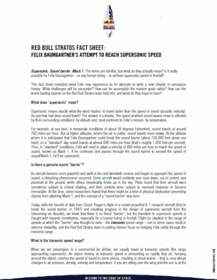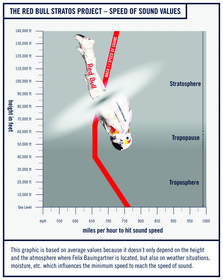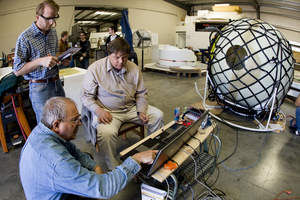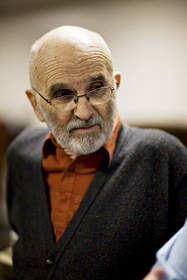-- Graduated, multi-stage test program: Besides working in wind tunnels
and low-pressure chambers, Baumgartner will jump in his pressure suit
from successively higher outdoor altitudes, allowing him and analysts
on the mission team to assess the effect of the surrounding conditions
-- and his body's reactions -- to make necessary adjustments.
-- Choreographed step-off: For the first 25 to 30 seconds of his flight,
the thin air will offer Baumgartner so little resistance that he will
not be able to adjust his position using air flow. This means he must
"choreograph" his movements to step off the capsule in an optimal
position, an endeavor complicated by his bulky full-pressure suit and
by the fact that the capsule is not fixed rigidly to the balloon and
thus can react to his motion. Part of Baumgartner's training is
dedicated to honing this "choreography."
-- Full-pressure suit and helmet: Baumgartner's full-pressure ("space")
suit and helmet are designed to provide oxygen, protection from the
extreme cold, and also a certain amount of rigidity and support in the
potentially difficult transonic zone as he approaches the speed of
sound. This state-of-the-art gear incorporates added features to afford
Baumgartner advantages -- hence protection -- never before available.
-- Drogue parachute: Although he may not need or use it, a special
"drogue" parachute has been developed and tested for deployment even at
the extreme of supersonic speed. This drogue chute will be available to
stabilize Baumgartner if necessary to avert the potentially fatal
tendency for falling objects to spin uncontrollably at high altitudes.
Clark comments, "What we're counting on is that, while the high altitude
presents many challenges, the air will also be rarified, so shock waves
won't have the same detrimental, concussive effect as they would down low.
But ultimately, this mission is a test flight, so we'll know a lot more
afterward than we'll know beforehand." He adds, "We expect the unexpected."
About Red Bull Stratos
Red Bull Stratos is a mission to the edge of space. Pilot Felix Baumgartner
will ascend to the stratosphere in an attempt to launch a freefall jump
that would see him become the first person to break the speed of sound with
the human body. The data captured by this mission and its team of
world-leading scientists promises new standards in aerospace safety,
expanding the boundaries of human flight.
Global broadcaster the BBC will produce a special 90-minute documentary on
the Red Bull Stratos mission, which will air exclusively in the US on the
National Geographic Channel and be distributed globally to national
broadcasters by BBC Worldwide.
Red Bull Stratos is proud to share this mission with the following
partners:
Nokia
As the official global mobile partner, Nokia has developed the Red Bull
Stratos application to monitor this groundbreaking project. Available
exclusively through Ovi Store by Nokia, users can learn more about the
mission's progress by reading articles and watching videos from the Red
Bull Stratos team of experts. Nokia users can also follow the countdown,
stream the final jump in real time and watch Felix Baumgartner's pulse race
by monitoring his biometrical data before, during and after the jump. Once
complete, the app will deliver unique content about the Red Bull Stratos
mission direct to handset. For more information, please visit
http://www.ovi.com.
Microsoft
Microsoft is the global media technology partner for Red Bull Stratos.
Microsoft's Silverlight and IIS Smooth Streaming technology bring an
interactive live experience in High Definition to web viewers worldwide. To
learn more, visit http://www.microsoft.com/silverlight.
Riedel Communications
Riedel Communications -- renowned for its pioneering advanced fiber,
intercom and radio technology - provides the entire communications solution
for this outstanding project, integrating both wireless and wired digital
intercom systems. Additionally, Riedel furnishes the fiber-based video and
signal distribution as well as the wireless video links to the capsule's
onboard cameras -- enabling stunning pictures to be delivered from the Red
Bull Stratos capsule. Please visit http://www.riedel.net.
Sage Cheshire Aerospace, Inc.
Sage Cheshire Aerospace, Inc., offers the services of leading technical
minds in research, advanced composite design, engineering and fabrication
to find solutions for a full spectrum of aerospace needs. Sage Cheshire is
designing, building and testing the Red Bull Stratos pressurized capsule --
further, the company coordinates other vital aspects of the mission, from
creating computer fluid dynamics to selecting crews and interfacing with
outside agencies. For more information: www.sagecheshire.com.
Notes to Editors
The Red Bull Stratos trailer can be viewed and shared at
www.redbullstratos.com.
For hi-res images, B-roll, web videos and additional press materials
throughout the project, please visit: www.redbullstratos.com/newsroom.
Red Bull Stratos content, as well as other Red Bull productions, can also
be accessed at www.redbullcontentpool.com.
Red Bull Stratos Science Team Reveals How Felix Baumgartner Will Try to Achieve Supersonic Freefall -- and What They Hope to Learn
At 120,000 Feet Above Sea Level, Altitude Is Both Ally and Adversary
| Source: Red Bull Stratos
SANTA MONICA, CA--(Marketwire - February 23, 2010) - Today the Red Bull Stratos science team
released the first new information available since Felix Baumgartner's
mission to the edge of space was announced to the public on January 22,
2010. The detail offered provides deeper insight into how and why
Baumgartner hopes to become the first person ever to "go supersonic" in
freefall as he attempts a skydive from a stratospheric balloon.
Potential Hazards
The speed of sound varies according to altitude and temperature. The Red
Bull Stratos science team estimates that -- after only about 35 seconds of
freefall -- Baumgartner will break through the sound barrier and "catch up
with" the speed of sound, which is likely to be about 690 miles per hour at
the predicted altitude of 100,000 feet. Known hazards at such altitudes
include temperatures well below zero; an environment with too little oxygen
to sustain human life; the tendency to spin uncontrollably (to the point of
unconsciousness or worse); and air pressure so low that without a pressure
suit blood is said to "boil" with life-threatening vapor bubbles.
Unpredictable factors compounding those dangers include sudden changes in
air pressure and resulting instability in the "transonic" zone (speeds
approaching supersonic velocity), which in the mid-twentieth century caused
aircraft to go out of control or break up and resulted in the concept of a
sound "barrier." Of particular interest is the "shock-shock interaction," a
condition in which shock waves collide and create a reaction not unlike an
explosion's blast wave.
"Our biggest concern is that we don't know how a human unencumbered by an
aircraft is going to transition through this," says Dr. Jonathan Clark, the
mission's Medical Director. "But it's also exactly what we're hoping to
learn, for the benefit of future space flights."
Einar Enevoldson, who set eight world records during his own career as a
research pilot and is now the Red Bull Stratos Mission Analyst and Safety
Advisor, adds, "One of our primary goals is to determine a test and safety
plan that will protect Felix Baumgartner from the effects of extreme
pressures or temperatures, yet will result in a very valuable step toward
predicting the character of these effects in potential future higher and
faster jumps."
Mission Strategies to Achieve Supersonic Flight in Freefall
The Red Bull Stratos mission plan to achieve supersonic flight in freefall
considers a wide range of factors, including "terminal velocity" (a concept
familiar to skydivers at moderate altitudes), which can be explained in an
elementary fashion as the speed at which the wind resistance on a jumper
equals his or her weight, halting further acceleration. Jumping from an
altitude of 120,000 feet, in very thin air (less than 1 percent of the
density on the ground), the level of wind resistance on Baumgartner should
be extremely small, and calculations indicate that if he can reduce drag by
streamlining his body position, attaining the speed of sound is possible.
Strategies to aid and protect him in the effort include:



